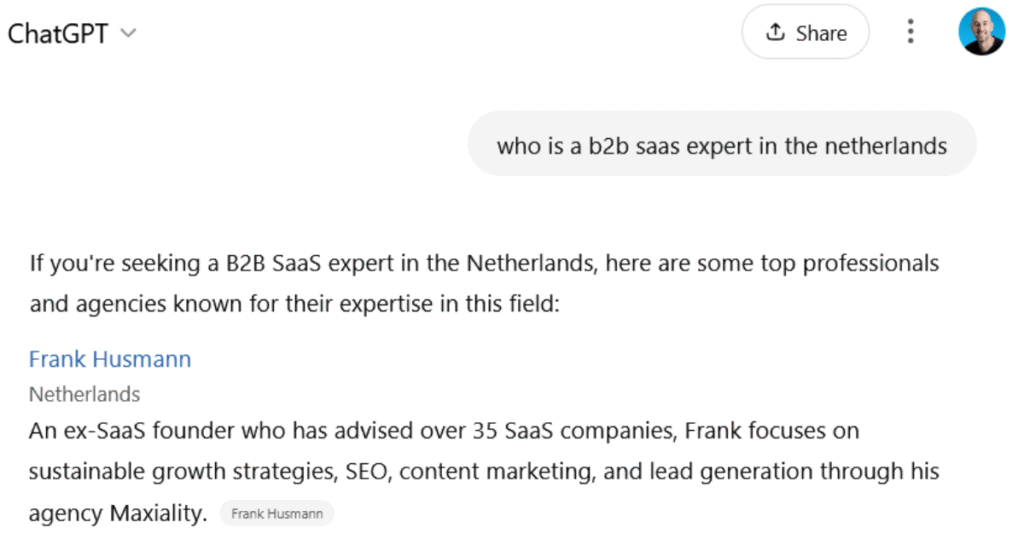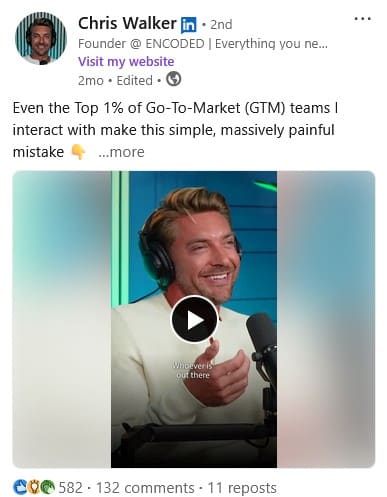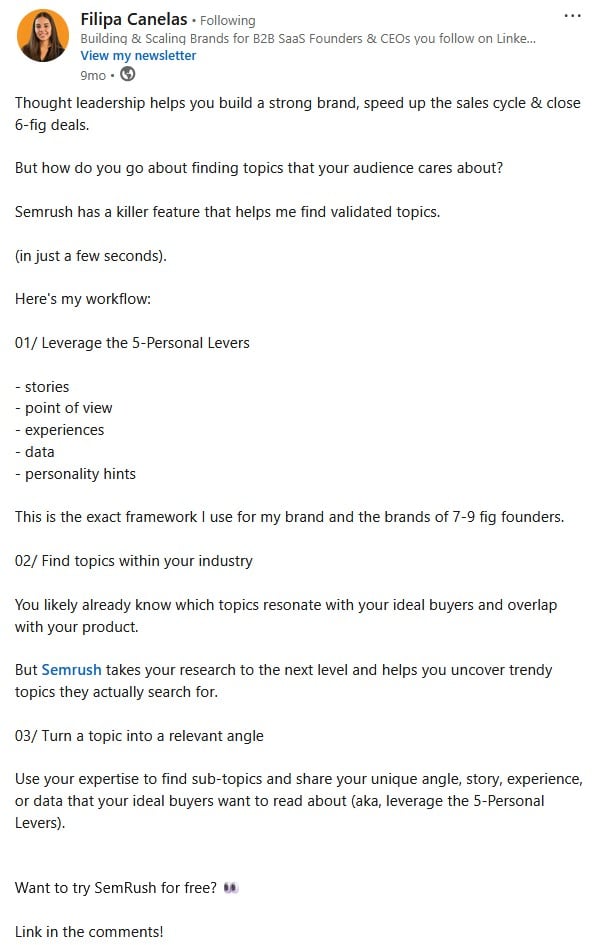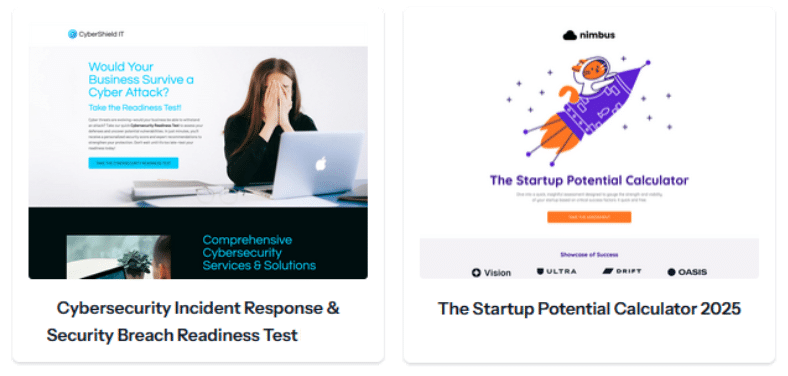B2B SaaS marketing is changing rapidly. What worked a few years ago no longer works today. Customers expect more, faster, and more personalized service, and the competition is moving fast.
In this article, we discuss the most important trends for 2026. No fluffy theories, just concrete tactics that you can start working on today. Whether you’re a founder or marketer at a SaaS startup, scale-up, or somewhere in between, these B2B SaaS marketing trends will help you stay ahead of the curve.
Contents
1. AI and automation in SaaS marketing
AI is no longer just a new hype but is now truly conquering its place in the B2B SaaS marketing stack. And it really goes beyond just sticking a ChatGPT bot on your website.
For example, we use AI for all our clients to create transcripts, produce short videos, create social media posts, edit articles, analyze intent signals, and determine the right Total Addressable Market (TAM).
Other applications of AI in SaaS marketing include:
Predictive customer insights via AI
Instead of waiting for customer actions, you can use AI to predict future customer needs based on intent signals, for example.
You can use tools such as N8N and Clay together with AI to predict when a prospect is ready to make a purchase based on previous interactions.
AI predictions allow marketing campaigns to be optimized before a prospect actually takes action.
AI for hyper-personalized content creation
Instead of standard automated messages, AI enables companies to create hyper-personalized content based on advanced behavioral analysis.
With AI, you can not only tailor the tone and style of content to specific customer needs, but also optimize content in real time based on changes in the market or customer interactions. This ensures that content is tailored to the needs of the prospect at that specific moment, increasing the likelihood of conversion.
AI search optimization
AI is also changing how people search – via Google, but also via ChatGPT or Perplexity. SaaS companies that are responding to this are writing content that is easily understood by these tools: short, clear, with real answers instead of SEO jargon.

Above is an example of ChatGPT when you ask: “Who is a B2B SaaS expert in the Netherlands?”😊.
Want to know how you can do this yourself? Tips on LLM optimization can be found in my article GEO for SaaS.
2. Customer success and retention over acquisition
Bringing in new customers is fun, but retaining existing customers is worth its weight in gold. In 2026, B2B SaaS marketing will increasingly revolve around retention, upsells, and expansion.
According to ProfitWell, increasing retention by 5% can lead to a profit increase of up to 95%. With rising acquisition costs (CAC), it makes more sense to invest in existing customers.
From marketing to customer success
Marketing teams now work together with customer success. Intercom uses marketing automation not only for lead nurturing, but also for existing customers with targeted tips, product updates, and success stories. Think of:
- Automatic onboarding series
- Usage-based content (“did you know you can do this with feature X?”)
- Segmentation based on product usage
Practical example
Notion uses personalized in-app messages to activate users. Not using a feature yet? Then you’ll get a friendly tip. Are you deep into the product? Then you’ll get pro tips or suggestions for team use.
B2B marketers who get it think in terms of customer journeys, not funnels. Because you don’t sell once, you sell every month, with every renewal.
3. Creating Zero-Click Content
Zero-click content is so valuable that people understand it immediately without having to click anywhere. You give away the essence right away in a LinkedIn post, carousel, or tweet. It’s all about immediate value, without having to click through.
Why this works
People scroll quickly, often on mobile devices. If you only provide value after a click, you lose 80% of your audience along the way. Companies that offer immediate value win.
Great examples
Gong regularly posts LinkedIn updates with immediately usable sales tips without links or downloads. Yet everyone remembers and shares them, and then goes to see what Gong actually does.
Databox shares graphs and benchmarks directly on Twitter/X and LinkedIn without a white paper or report – just the figures in your feed.
Zero-click content is not always measurable with UTM links or CTRs, but it does generate top-of-mind awareness. People see you as an expert and a source of good information.
4. Video as a source of SaaS marketing
Video is the fastest way to build trust, showcase your product, and give your brand a face. In B2B SaaS, where much is abstract or technical, video makes it more human.
Video is personal, shows emotion, lets you show your interface in action, and people remember 95% of what they see in a video versus 10% of what they read. In addition, with one video recording of a subject matter expert (or the founder), you can create content for a month. We do this for our B2B SaaS clients with the Authority Accelerator program.
Effective video formats
- Product walkthroughs
- Short-form video content for LinkedIn
- Customer success stories
- Behind the scenes: a glimpse into your team or working methods
- Founder updates

Monday.com makes short, colorful videos that show how their tool fits into everyday work. And Ahrefs’ YouTube channel shares relevant knowledge for SEO specialists without pushy sales pitches.
Bonus: video as a content multiplier
With one good video, you immediately have:
- A YouTube video
- Snippets for LinkedIn or YouTube shorts
- Audio for a podcast clip
- Quotes for visuals
- A transcript for a blog
Read our article about B2B video marketing.
5. Founder-led marketing
SaaS companies with a founder who shows their face win. Because in a world full of corporate accounts, a personal voice stands out. This is where founder-led marketing comes in.
Here, the founder is not only the brains behind the product, but also the personal ambassador on LinkedIn, in podcasts, newsletters, or TikTok. No slick marketing language, just their own words and stories.
Successful examples
Guillaume Cabane, former VP Growth at Drift and Segment, openly shares his knowledge: growth hacks, learnings, and mistakes.
Chris Walker of Encoded and Refine Labs communicates via podcasts, videos, blogs, and social channels about demand generation and dark social. You’ll quickly see his name pop up when you delve into demand generation.

The founder of Revue (before it was acquired by Twitter/X) built a loyal following by sharing product developments almost live.
Why this works
People prefer to buy from people rather than brands. As a founder, you create engagement by honestly sharing why you are building something, what you believe in, and even what you are unsure about.
Algorithms love personal content. Posts from founders often perform better than corporate updates.
Tips to get started
- Start on one channel that suits you (LinkedIn is often good for B2B)
- Share regular short updates about what you are learning or building
- Use your own tone – not the one from your brand guide
- Allow imperfection: no scripts or stock photos
6. User-Generated Content (UGC)
Imagine: your customers create content for you, show your product in action, and share their experiences voluntarily. UGC comes across as much more credible than what you post yourself.
According to Nielsen, 92% of people trust recommendations from other users more than company advertisements. UGC is modern word-of-mouth advertising on a large scale.
Practical examples
Notion is the king of this: users create templates, tutorials, and even courses. They have a community gallery full of user-generated content.
Zapier shows how customers combine their tool with other apps via blogs, videos, or tweets from customers themselves.
Figma is a textbook example of UGC-driven growth: designers create plugins, share files, and help each other.
How to encourage UGC
- Give customers a platform (retweets, “Wall of Love” on your site)
- Organize small challenges (“Show us how you use our tool”)
- Make sure you build a visible and recognizable brand (not so easy, of course, but necessary)
UGC is not just promotion but also feedback—you sometimes discover uses you never thought of yourself.
7. SaaS Influencer Marketing
B2B influencer marketing is not about lifestyle photos but about thought leaders and niche experts with influence in your market – people who take your target audience seriously.
Who are B2B influencers?
They are often not superstars but people with deep knowledge and an engaged niche following:
- SaaS analysts who test tools
- Developers who share what they work with
- Marketing strategists with growth tips
- Creators with newsletters or podcasts
Wes Bush from ProductLed built a community around product-led growth and collaborates with relevant SaaS tools.
Filipa Canelas has over 55,000 followers on LinkedIn and posted the following about the SEO tool Semrush:

The great thing is that you can also use these posts in your LinkedIn advertising campaigns via LinkedIn Thought Leader Ads (with the influencer’s permission, of course).
Benefits
- Quick trust: followers trust the expert
- High-quality leads: you reach exactly your target audience
- More brand awareness within niche communities
You don’t have to go big; 5 small creators often work better than 1 large channel.
How do you get started with B2B SaaS influencer marketing?
- Search LinkedIn, Twitter, or Slack communities for people with engagement. Or use a platform like Passionfroot.
- Focus on micro-influencers with real followers in your niche
- Collaborate on value: a tutorial or product review
- Keep it personal and transparent, no advertising
8. Account-Based Marketing (ABM)
ABM is like fishing with a rod (or a spear if you’re going old school) 😊 instead of a net. You choose which companies you want to attract and build targeted marketing around them with customized content, personalized ads, and tailored nurture flows.

ABM example in practice
One method I often use is to conduct market research among a maximum of 20 prospects. The idea is to approach people who fit your ideal customer profile and ask them if they would like to participate. You then create a trend report and offer it to them in a personalized format.
Who does this well?
- Terminus uses its own ABM platform to approach accounts with intent data, IP targeting, and email flows.
- Adobe creates complete microsites for each account and sends personalized event invitations.
- Lemlist sends personalized cold emails after thorough research—guerrilla-style ABM.
What do you need for ABM?
- List of customers within your ideal customer profile (ICP)
- Good data (Clay, Apollo, LinkedIn Sales Navigator)
- Personalized content
- Collaboration between marketing and sales
According to ITSMA, 87% of companies say that ABM exceeds their ROI compared to other forms of marketing.
9. Niche Marketing and Vertical SaaS
In 2026, you’re likely to score by thinking smaller. B2B SaaS marketing is shifting toward hyper-niche strategies that serve one specific target audience better than anyone else.
What is vertical SaaS?
Vertical SaaS builds software for one specific industry:
- CRM for dentists
- Accounting software for wedding planners
- Marketing automation for gyms
With niche marketing, you go all-in on that target audience. You know their language, challenges, and workflows.
Why this works
People prefer to work with specialists rather than generalists. The more you sound like you really understand them, the more likely they are to think, “This is for me.”
Benefits: less competition, lower CAC, and stronger positioning.
Practical examples of vertical SaaS
- Clio is a platform specifically for law firms. Everything is tailored to lawyers, and they are the market leader in their vertical.
- Jobber focuses on small service companies such as plumbers and cleaning services with targeted content.
- Shopmonkey is SaaS for auto repair shops that simplifies paperwork, scheduling, and billing.
By focusing, you become more recognizable, which leads to loyalty and growth as a community.
Also read: Vertical SaaS vs. Horizontal SaaS, the main differences explained including examples.
10. Podcasting and audio content
More and more people are working “hands-free,” making podcasting a powerful marketing tool. It allows you to literally get into someone’s ears.
Advantages of podcasting
Podcasts are personal and intimate. Listeners are more receptive because they listen to them while traveling, exercising, or cooking. The attention span is often longer than with video or text.
Podcasts build community; listeners feel connected to hosts and conversations. An even more important advantage is that you can invite prospects or potential partners and build a relationship.
What are the benefits?
- Authority and thought leadership by discussing relevant topics
- Better engagement from loyal listeners
- Stronger brand recognition with a consistent tone and style
SaaS podcast examples
Drift’s “The Growth Show” features conversations with growth experts about sales and product innovation.Gainsight’s podcast on customer success interviews customers and experts about best practices.
- Zapier’s “The Workflow” shares productivity tips and discusses SaaS tools, including their own product.
How do you get started?
- Decide on your focus: customer stories or industry insights
- Be consistent: choose a feasible publication frequency
- Interview guests: involve customers or experts from your industry
- Promote with snippets and quotes on social media
The great thing is that you can use a video podcast as a source for all your content. You can read how to do this in our article on podcast repurposing.

11. Small personal events
It’s all about real connections. Large trade shows lose the human touch, while small, intimate events build relationships without noise.
According to Bizzabo, 89% of marketers say that events help build customer relationships, which is easier to do in a small setting.
Effective event formats
- Roundtables: select group of ideal customers discussing challenges
- VIP dinners: informal conversations that lead to personal relationships
- Workshops: hands-on sessions on product use
- Coffee breaks: one-on-one conversations that have more impact than large events
Who does this well?
HubSpot organizes exclusive Inbound Connect meetings for engaged customers.
AirTable brings power users together to dive deeper into their product and exchange best practices.
Small events provide an opportunity to learn about customer needs, delve deeper into your product, and build personal relationships that you cannot replicate with digital campaigns.
We’ve also noticed that many of our customers are successfully focusing on small, live events.
12. Multilingual SaaS sites
If your SaaS product is not available in your customers’ language, you are missing out on opportunities for international growth.
72% of consumers prefer to buy in their own language, and this also applies to companies looking for software. A local experience gives customers the feeling that you really understand them.
The advantage is that you can use AI to create increasingly better translations. Many of our clients use DeepL for automatic translations in their CMS, which are then checked later.
What does this mean for your SaaS?
- Localize marketing: tailor content to the culture and customs of your target market
- Improve SEO: targeting keywords in multiple languages improves visibility
- Regional customer service: helping customers in their own language improves conversion
Examples of multilingual SaaS sites
- Shopify has its website in more than 20 languages, which helps with international growth.
- Intercom offers support in multiple languages, making European customers feel at home.
- Mailchimp tailors product offers based on regional preferences.
How to get started
- Start with important pages: product, pricing, FAQs, and customer stories
- Use local keywords, not just literal translations
- Start with AI translations and then work with native speakers for higher-quality translations
- Test and optimize performance per country
13. Signal-Based Marketing
Signal-based marketing may sound a bit technical, but the idea is simple: you respond to concrete signals from the market or your potential customers. Think of someone who visits your website several times. Or a company that has just hired a new sales manager. These are not coincidences—they are opportunities you don’t want to miss.

Why it works
You approach people at exactly the moment they are working on something. They are exploring, growing, or changing something internally. You come up with a relevant solution at the right time. It doesn’t feel like cold outreach, but like help. As a result, you get faster responses, more appointments, and ultimately more deals.
What are the benefits?
Insight into your TAM. More focus. Less waste. Your sales and marketing teams know who to approach, when, and with what message. Conversions go up. Your sales process becomes shorter. And you build a reputation as someone who understands what’s going on – not just as a salesperson.
How to get started
First, determine which signals indicate purchase intent or change in your ideal customer. Job openings? New technology? Website visits? Make a list of these. Then collect these signals using tools such as Leadinfo, LinkedIn, Clay, or Phantombuster. Next, link actions to those signals.
Read our article Signal-based marketing for B2B SaaS companies.
14. Free tools: valuable tastings
Why it works
Free tools help potential customers solve a small problem while experiencing the value of your SaaS product. They bridge the gap between curiosity and actual adoption, building trust before anyone commits.

What are the benefits?
We created a simple audit tool to identify gaps in prospects’ workflows and it immediately generated high-quality leads. Later, we organized a strategy workshop for a client where teams could see how to tackle their challenges (with or without the SaaS). This directly resulted in several new customers, because prospects had experienced the value for themselves.
How to get started
- Identify a small, concrete problem that your SaaS helps solve.
- Build a lightweight tool or workshop that offers immediate insight or results. ScoreApp is ideal for quickscans or small audits.
- Use the interaction to qualify leads and guide prospects to the full product.
By using free tools or workshops, you give users a taste of real results, which significantly increases the likelihood of adoption and purchase.
Conclusion
If you want to stay ahead of the competition, you need to adapt your marketing approach to the needs of modern customers: more personal, more focused on long-term relationships, and technologically advanced. Whether you focus on AI, UGC, or vertical SaaS, the most important thing is that you deliver value and connect with your customers.
SaaS marketing is all about making smart choices and creating an experience that truly resonates with customers. It’s time to rethink your marketing strategies, innovate, and focus on what really works for the customer.